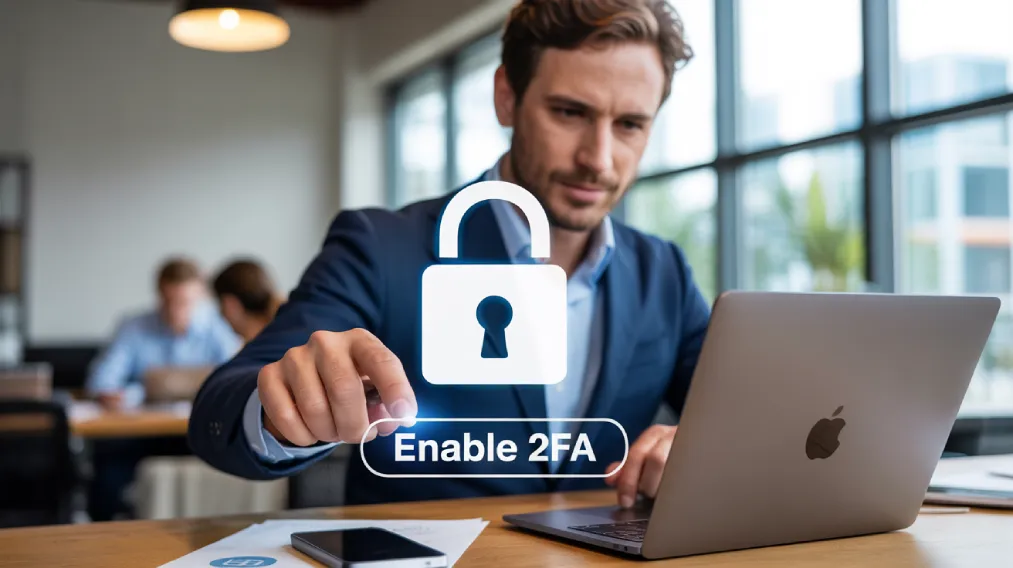
Think your small business is safe from cyber threats just because you’re not a big corporation? Well, think again. Cyber criminals are increasingly targeting small businesses precisely because they know these companies often lack strong defenses. In fact, nearly half of all cyberattacks today are aimed at small and mid-sized businesses. If you’re running a lean operation, every dollar counts – and a cyberattack can cost you more than just money. It can damage your reputation, disrupt operations, and erode customer trust overnight.
The truth is, cybersecurity for small business is no longer optional – it’s essential. While big enterprises have entire IT departments, small business owners often wear many hats and don’t have time or expertise to think about digital threats. But here’s the good news: you don’t need to be a tech expert or spend a fortune to protect your business.
This article breaks down everything you need to know about cybersecurity for small business – what the real threats are, why you’re a target, and most importantly, what affordable steps you can take today to stay protected. Whether you’re running a retail shop, managing a consultancy, or offering online services, this guide will definitely help you get started.
Contents
- 1. The Modern Cyber Threat Landscape: What’s Really Out There?
- 2. Why Small Businesses Are Prime Targets
- 3. What Is Cybersecurity for Small Business?
- 4. Types of Cyber Threats Facing Small Businesses
- 5. The Cost of a Cyberattack (It’s More Than Just Money)
- 6. Early Signs You’ve Been Hacked
- 7. Cybersecurity on a Budget: Simple, Affordable Measures That Work
- 8. Cybersecurity Is an Ongoing Process, Not a One-Time Task
- 9. Ready to take Action? The 5-Day Cyber Tune-Up Challenge!
- 10. Final Thoughts: Cybersecurity IS Business Survival
1. The Modern Cyber Threat Landscape: What’s Really Out There?
Before you can protect your business, you need to understand what you’re protecting it from. The modern cyber threat landscape has evolved far beyond the occasional scam email. Today’s threats are more sophisticated, more frequent, and more damaging than ever—especially for businesses with minimal digital defenses.
Here are the most common threats small businesses face today:
- Phishing Attacks: These are fraudulent messages—often emails—that trick you or your team into giving away sensitive information, like passwords or payment details. Over 90% of successful cyberattacks begin with a phishing email.
- Ransomware: This form of malware locks you out of your data and demands a ransom to unlock it. According to a 2023 report by Cybersecurity Ventures, global ransomware damage costs are projected to exceed $30 billion annually by 2025.
- Data Breaches: A breach can expose sensitive customer information like emails, phone numbers, or credit card data. This not only violates data protection laws but also seriously damages customer trust.
- Business Email Compromise (BEC): Hackers impersonate business executives to trick employees or vendors into making payments to fraudulent accounts.
- Insider Threats: Sometimes, the danger is internal. Disgruntled or careless employees can accidentally (or intentionally) compromise your systems.
Cybersecurity for small business means staying informed. Understanding these threats is the first step toward defending your operations. They’re not just targeting giant companies – they’re targeting you because they know you’re less likely to be protected.
2. Why Small Businesses Are Prime Targets
There’s a common perception that only large enterprises get hacked. But global data tells a different story. According to the Verizon Data Breach Investigations Report, 43% of all cyberattacks target small and medium-sized businesses (SMBs).
Why? Because small businesses typically:
- Lack formal cybersecurity policies
- Don’t provide staff with training on digital threats
- Use outdated systems and software
- Rely on personal devices for business operations
- Have weak password management practices
In short, many small businesses are low-hanging fruit for attackers. Hackers don’t need to spend time or resources cracking a complex firewall when they can phish a small business owner or employee with a convincing fake invoice email.
3. What Is Cybersecurity for Small Business?
Cybersecurity refers to the practices and tools used to protect your business’s digital assets — including customer data, payment information, communications, and operational systems — from unauthorized access, damage, or theft. For small businesses, this includes:
- Safeguarding your website and e-commerce platform
- Protecting employee and customer data
- Securing point-of-sale systems and accounting tools
- Defending against phishing, ransomware, and malware
Put simply: if your business uses the internet in any form, you need to think about cybersecurity.
4. Types of Cyber Threats Facing Small Businesses
Understanding the threats can help you better prepare. Here are some of the most common cyber threats small businesses face:
1. Phishing Attacks
Fake emails or messages tricking employees into revealing passwords, clicking malicious links, or sending money to fraudsters.
2. Ransomware
Malicious software that encrypts your files and demands payment for their release. These attacks can halt operations for days or weeks.
3. Data Breaches
Hackers gain access to sensitive customer or business data — which can lead to legal consequences and loss of trust.
4. Business Email Compromise (BEC)
Scammers impersonate company executives or suppliers to reroute payments or access confidential information.
5. Malware and Spyware
Infect devices through infected downloads or email attachments, stealing data silently over time.
6. Password Attacks
Hackers exploit weak or reused passwords to access business accounts and systems.
Even a single incident can cripple a small business, impacting it financially and affecting its reputation.
5. The Cost of a Cyberattack (It’s More Than Just Money)
Cybersecurity incidents can be financially devastating. According to research by IBM, the average cost of a data breach for small businesses is $2.98 million. While not every attack results in this level of loss, many small businesses don’t have the cash reserves to survive even a fraction of that.
But the costs go beyond dollars and cents:
- Lost in revenue when your business operation had to be stopped
- Regulatory fines for failing to provide data protection
- Customer churn from them losing trust in your business
- Reputation damage that’s hard to rebuild in this competitive market
- Legal fees and lawsuit settlements from data protection laws
- Loss of Competitive Edge from IP theft can really set you back
Some businesses never recover. A study by the U.S. National Cyber Security Alliance found that 60% of small businesses close within six months of a cyberattack.
Cybersecurity for small business is no longer optional – it’s the shield that keeps your business standing in a digital-first world.
6. Early Signs You’ve Been Hacked

Many small businesses don’t even know they’ve been hacked until the damage is done. Here are some early warning signs to watch for:
- You or your customers start receiving strange or spammy emails from your domain
- You get login alerts from unusual locations or devices
- Files become inaccessible or encrypted
- Software or systems start behaving unpredictably
- Unfamiliar charges or transactions appear
- You’re locked out of important accounts
If you feel something is off, act immediately. Delays can make the situation worse.
7. Cybersecurity on a Budget: Simple, Affordable Measures That Work
You don’t need a six-figure IT budget to protect your business. Here are low-cost (and often free) steps you can take today.
1. Educate Your Employees
Human error ranks high as cause of data breaches. Train employees to:
- Identify phishing emails
- Avoid clicking suspicious links
- Use secure file-sharing methods
- Report strange behavior promptly
2. Use Strong Passwords & 2FA
- Use unique passwords for each account
- Don’t reuse personal passwords for business
- Use a password manager like LastPass or 1Password
- Enable 2-Factor Authentication (2FA) wherever possible
3. Regular Backups
- Backup critical business data regularly
- Use both cloud-based and offline (external hard drive) solutions
- Test your backups to ensure they can be restored when needed
4. Update Your Systems
- Keep operating systems, browsers, and antivirus software up to date
- Remove unsupported or outdated software
- Enable auto-updates where available
5. Secure Your Wi-Fi Network
- Change default router passwords
- Use strong Wi-Fi encryption (WPA3 or WPA2)
- Separate guest networks from business networks
6. Limit Access
- Only give employees access to systems or files they need
- Implement role-based permissions for cloud tools or internal systems
- Revoke access for former staff immediately
Cybersecurity for small business is about doing the basics consistently. These steps don’t require a big budget – just commitment. Start small, stay vigilant, and build up your defenses over time.
8. Cybersecurity Is an Ongoing Process, Not a One-Time Task
Many small business owners make the mistake of setting up basic antivirus or firewalls and thinking the job is done. But cybersecurity is like health – it needs regular checkups and daily habits.
- Review your security practices monthly
- Test your backups quarterly
- Update software as soon as updates are available
- Re-train your staff at least once a year
- Audit account access after staffing changes
A little regular effort can save you from a big, expensive headache down the road.
9. Ready to take Action? The 5-Day Cyber Tune-Up Challenge!

Want a simple way to get started? Try this 5-day plan – just 15 minutes a day.
| Day | Task |
|---|---|
| Day 1 | Change passwords for all key accounts and set up 2FA |
| Day 2 | Backup all essential data (cloud + offline) |
| Day 3 | Run a phishing awareness test with your team |
| Day 4 | Update all software on computers and mobile devices |
| Day 5 | Secure your Wi-Fi network and router settings3 |
10. Final Thoughts: Cybersecurity IS Business Survival
Small doesn’t mean safe. In fact, small businesses are increasingly seen as low-hanging fruit by cyber criminals. Even if you think your business is too small or not “techy” enough to be targeted, the truth is this: if you’re connected to the internet, you’re a potential victim.
But here’s the good news: cybersecurity for small business doesn’t have to be expensive, complicated, or overwhelming.
You don’t need to panic. You just need to start.
Start by:
- Building awareness
- Training your team
- Using basic cybersecurity tools
- Backing up your data
- Reviewing your setup regularly
Cybersecurity isn’t just about technology—it’s about protecting the business you’ve worked so hard to build. It’s about safeguarding your customer trust, your operations, and your future.
So while you may be small, your mindset doesn’t have to be. Think smart. Stay secure. And don’t wait until it’s too late.

